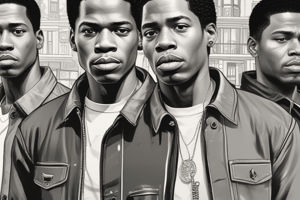Podcast
Questions and Answers
What is implied about Mr. Bumble's proposal to Mrs. Corney?
What is implied about Mr. Bumble's proposal to Mrs. Corney?
- He is trying to reform the workhouse
- He is genuinely in love with Mrs. Corney
- He is interested in her material wealth (correct)
- He wants to help the paupers
What is the implied criticism of the Victorian era's middle-class marriages?
What is the implied criticism of the Victorian era's middle-class marriages?
- They were always unhappy
- They were too romantic
- They were often economic arrangements (correct)
- They were only for the wealthy
What is Mr. Bumble's attitude towards Mrs. Corney's possessions?
What is Mr. Bumble's attitude towards Mrs. Corney's possessions?
- He is admiring of her good taste
- He is appraising their value (correct)
- He is disgusted by her materialism
- He is indifferent to them
What is the author's view on marriage, as depicted in the novel?
What is the author's view on marriage, as depicted in the novel?
What is the effect of Monks's conversation with Fagin?
What is the effect of Monks's conversation with Fagin?
What is implied about Monks's character?
What is implied about Monks's character?
What is the atmosphere created by Dickens's description of Monks?
What is the atmosphere created by Dickens's description of Monks?
What is suggested by Monks's claim about the 'shadow of a woman'?
What is suggested by Monks's claim about the 'shadow of a woman'?
What is the main concern of Dickens in presenting two kinds of theft?
What is the main concern of Dickens in presenting two kinds of theft?
What is Mrs. Corney's lifestyle based on?
What is Mrs. Corney's lifestyle based on?
Why does Dickens describe Mrs. Corney's apartment?
Why does Dickens describe Mrs. Corney's apartment?
What is implied about the middle class in the novel?
What is implied about the middle class in the novel?
What is the irony in the dialogue between Mrs. Corney and Mr. Bumble?
What is the irony in the dialogue between Mrs. Corney and Mr. Bumble?
What is the effect of the middle class's control over conceptions of right and wrong?
What is the effect of the middle class's control over conceptions of right and wrong?
What is the attitude of the middle class towards the lower class?
What is the attitude of the middle class towards the lower class?
What is the purpose of Mr. Bumble's remark about drowning a cat?
What is the purpose of Mr. Bumble's remark about drowning a cat?
Flashcards are hidden until you start studying
Study Notes
Social Commentary in Oliver Twist
- Dickens highlights the hypocrisy of the middle class by contrasting two forms of theft: overt theft by characters like Sikes and Crackit, and subtle theft by characters like Mrs. Corney, who exploit the poor for personal gain.
Social Inequality in the Workhouse
- Mrs. Corney, the matron of the workhouse, enjoys luxurious living conditions while the paupers are cramped and cold, highlighting the vast social inequality in the institution.
- The workhouse paupers are treated worse than animals, deprived of basic human rights, while Mrs. Corney's cat and kittens enjoy better living conditions.
Middle-Class Hypocrisy
- Mrs. Corney and Mr. Bumble, representatives of the middle class, are guilty of hypocrisy, condemning obvious theft while ignoring their own exploitative behavior towards the poor.
- The middle class controls the narrative of right and wrong, allowing them to rationalize their own thievery and condemn that of the lower classes.
Satire of Middle-Class Values
- Dickens satirizes the materialistic nature of middle-class marriage, as exemplified by Mr. Bumble's proposal to Mrs. Corney, which is motivated by her wealth rather than love.
Introduction of Mystery and Suspense
- The introduction of Monks, a mysterious figure, marks the beginning of a detective-like storyline, as the reader is left wondering about his identity and motives.
- The novel takes a darker, more suspenseful tone with the description of Monks as a "dark figure" lurking in the shadows.
Studying That Suits You
Use AI to generate personalized quizzes and flashcards to suit your learning preferences.



